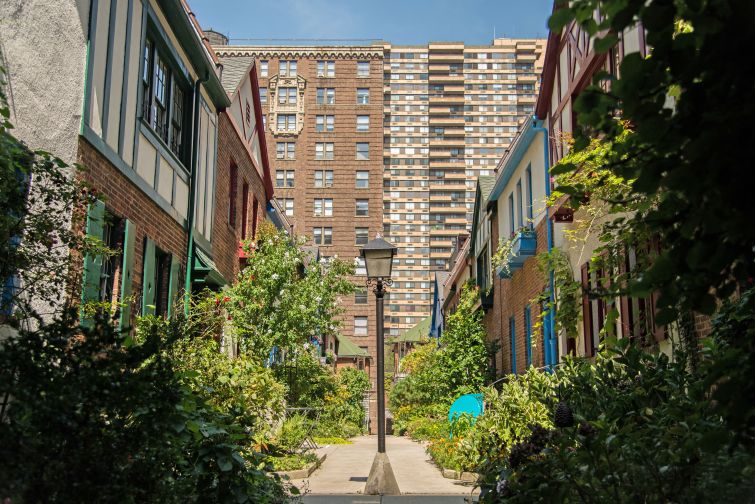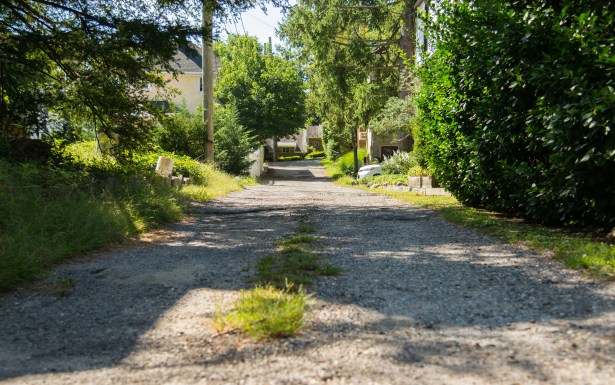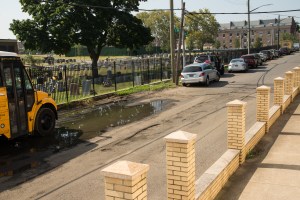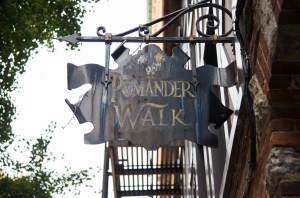Keeping It Private: Homeowners Struggle With Life on NYC’s Private Streets
So-called exclusive streets that are owned by residents live in a state of limbo as far as the city is concerned...even if they’re gorgeous
By Nicholas Rizzi September 11, 2018 11:45 am
reprints
Twice a week, 71-year-old Douglaston, Queens, resident Peggy Kalesis packs her trash-filled garbage cans into the back of her SUV and drives half a block from her home.
She and her dozen Stuart Lane neighbors drop their trash in front of an understanding Depew Avenue resident’s home because Stuart Lane is one of the nearly 1,000 private streets across the five boroughs that doesn’t get its garbage picked up by the city.
“It’s horrible,” Kalesis said. “We do pay taxes. We feel like we’re not getting city services.”
Private streets are owned, and tended to, by residents, homeowners associations (HOAs) or co-op boards. While they show up on Google Maps, they aren’t on the official city map so agencies won’t collect trash, remove snow, pave roads, repair street lights, fix sewer lines and more. Some have even caused issues for 911 dispatchers.
Stuart Lane was owned by a family when Kalesis first bought her home 41 years ago, but after failing to pay taxes the city took it over from them and sold it along with an undeveloped lot at the end to Long Island architect Charles D’Alessio in 2000.
D’Alessio has let the 600-foot block deteriorate since he bought it, residents allege. It has large potholes and no street lights, forcing homeowners to buy SUVs and carry flashlights when walking home at night.
“He’s refusing to do anything,” said Kalesis, adding that D’Alessio joked he would install a toll booth to enter Stuart Lane when he first bought it. “We don’t know what to do anymore.”
D’Alessio did not respond to requests for comment.

The city’s Department of Transportation did not respond after nearly a month to a Freedom of Information Law request about the number of private streets around the city. A 2010 New York Daily News report found there were more than 900 across the five boroughs, with WNYC reporting Staten Island had the most in the city that year with 638. Today, there are 236 of them in Queens and 36 in Manhattan, according to the Manhattan and Queens borough presidents’ office.
The Staten Island, Brooklyn and Bronx borough presidents’ office would not provide how many private streets are in their boroughs.
State law requires all new homes in the city to be built fronting a street on the official map and it can take nearly seven years for a new block to be added. However, developers can get an exemption to build a private street leading to the homes, allowing them to fit more houses on a lot and cut down on the time.
“It’s a nightmare,” said Councilman Joe Borelli, whose represents the South Shore of Staten Island and previously owned a home on a private street himself.
“We deal with the problem initially with developers being able to build more houses then they normally could and then after 10 years we deal with it again when inevitably the HOA fails and they need to be repaved and catch basins that need to be dug and there’s simply no money.”
While some residents describe an idyllic life on a private street, others don’t know the maintenance required when they buy a home on one and later flood local officials with complaints.
“They see a house or an attached house and they can afford it. It’s a nice little private thing and it looks really good,” said Charlene Wagner, the district manager of Staten Island’s Community Board 3 who estimates she fields a call once a day from residents on private streets. “It looks great until you open the package and then you find out—that’s not what I signed up for.”
The streets include ones built in newer, sometimes gated, developments in more suburban neighborhoods run by either HOAs or co-op boards. Homeowners pay monthly fees and the HOA uses the funds to fix the streets and remove snow, when the association functions properly.
Others are small sections of a city-owned street that were inexplicably left off the official map when the city became the five boroughs in 1898, according to Brooklyn Councilman Alan Maisel.
“In some cases, [homeowners] don’t even know they own the street,” said Maisel, who has been fighting to get the city to take over some in areas like Canarsie. “If something happens like a sewer line breaks, theoretically, the people who own the street are responsible.”
City agencies point to a lack of insurance coverage for not picking up trash or removing snow in case workers get injured while on these streets.
New York City Department of Sanitation, or DSNY, “will not collect trash or recycling from private streets in the City of New York unless we have secured an insurance waiver from the residents of that street,” Vito Turso, a spokesman for DSNY, said in a statement.
“We also would need to establish that there were no safety concerns to our crews and equipment in potentially navigating those private streets,” he added. “There have been emergencies, like [Superstorm] Sandy, where we have provided emergency assistance on private streets for the safety of local residents.”
However, residents argue the city picks and chooses when to enforce these regulations. Kalesis said DSNY only stopped picking up trash on Stuart Lane a few years ago when the potholes got so bad it made driving down the block difficult. Homeowners on four private streets in Bay Ridge, Brooklyn—Barwell Terrace, Wogan Terrace, Hamilton Walk and Lafayette Walk—sued DSNY last year when garbage collection suddenly stopped after decades.
“You’ve got old people that are now bringing their trash the length of a football field and Sanitation are now concerned about the potential injury to workers,” said Bill Larney, who’s lived on Barwell Terrace for 22 years and is part of the suit. “We have a full tax burden like every other resident and now they’re taking away one of our city services.”
Larney added that DSNY told them about the possibility of getting an insurance waiver, but his Barwell Terrace neighbors would need to form an HOA first.
A judge is currently deliberating the residents’ suit and a DSNY spokesman declined to comment, citing pending legislation.
These issues have sparked action from several local lawmakers to get the city to take over existing private streets and tweak the process for ones being built for new developments. It’s unclear how many new ones get built a year.
Staten Island Borough President James Oddo has been railing against these private street projects for years claiming developers are exploiting a state law to maximize profits, build projects too dense for the neighborhoods and avoid the long Uniform Land Use Review Procedure needed to get a street on the city map. Oddo has used Staten Island builders and developers Savo Brothers’ controversial Mount Manresa development—which will have 20 townhouses on the site of a former Jesuit retreat house in Fort Wadsworth—as the poster child for the issue.
“Staten Islanders drive past a project and they say, ‘How the hell did that happen? Who allowed that to happen?’” Oddo previously told DNAinfo. “We would be making the same mistake with the Manresa site if we didn’t compel it to go through what [city law] really was intended for.”
Oddo and the Savo Brothers declined to comment.
The borough president’s office has the final power to approve the names of newly built private streets. In Mount Manresa, Staten Island, Oddo shot down the Savo Brothers’ original suggestions and stuck the development with Cupidity Drive, meaning an inordinate desire of wealth according to Merriam-Webster, Fourberie Lane, French for trickery and deception, and Avidita Place, derived from the Italian word avdità, meaning greed.
In a less petty move, Oddo also called on the Board of Standards and Appeals (BSA) to reject the Savo Brothers’ application to build the private roads for the project and avoid General City Law 36. The state law requires new homes be built fronting mapped streets before getting a certificate of occupancy, but builders can apply for a waiver from the BSA if they prove following it would be a hardship to developers, according to BSA Deputy Director Toni Matias.
“The board reviews applications on a case by case basis,” said Matias, adding the agency has talked about amending the process following Oddo’s complaints.
A waiver from the law helps developers cut down on the project’s costs and the timeline while letting them maximize the number of homes they can build on a parcel of land, according to a source who’s worked on several projects with private streets around the city.
“The reason people don’t put city roads in is the process to get city roads approved on a final map is seven years,” said the source, who did not want to be named because he’s currently involved in some of these developments. “Who the hell has the finances to wait seven years? [Creating private streets are a] quicker process and it’s not a burden on the city.”
While Oddo has been fighting new ones getting built, Maisel has been trying to help the residents who currently live on them. He authored a law last year forcing the city’s Department of Transportation to compile a list of all of them not owned by an HOA of co-op board—about 200—to consider taking control of them.
“DOT has received information provided by the Department of City Planning as well as a number of borough presidents,” Alana Morales, a spokeswoman for the DOT, said in a statement. “As required by law, DOT has also reviewed factors that may be generally considered and/or necessary for acquisition, but there is no immediate plan to take over these streets.”
Despite the agency’s disinterest, Maisel is still pushing for some in his district—especially Church Lane in Canarsie—to be taken over by the city. Only a small section of Church Lane wasn’t added to the city map, for reasons Maisel could never ascertain, and has no sidewalks and giant potholes, causing a near constant pool of water on the block.
“The city has parking regulation signs on it,” said Maisel, who posed for photos fishing in the pit earlier this year to show how deep the waters are. “If you assume that responsibility it should be your street.”

Residents were dealt a blow when the city repaved the seven-block Church Lane last year but didn’t touch the private section between East 88th and East 89th Streets.
“They make the roads right in front of the water and in the back of the water,” said David Amrusi, who’s lived on the block for 26 years. “They leave the problem. They look and they never come back.”
Life on a private street isn’t always hell and some in the city are highly sought after. The gated Bayside Gardens in Bayside, Queens has some of the priciest homes in the neighborhood while homes in Forest Hills Gardens in Forest Hills, Queens, remain in high-demand, according to Queens residential agent Parvaneh Rifino of brokerage Daniel Gale Sotheby’s International.
Homeowners also can have access to shared amenities—like a pool and a playground—and don’t have the deal with the struggle of finding a parking spot. Most of these streets don’t have alternate-side parking regulations and some even ban visitors from parking without a pass only available to residents and their guests.
Residents of the dozens of ones hidden away in Manhattan describe life on them as a quiet oasis in the concrete jungle.
“It felt very safe and we had wonderful, wonderful neighbors,” Natalie Weiss, a broker for the Corcoran Group who spent most of her life on the Upper West Side’s tiny and private Pomander Walk, said. “Everybody kind of looked out for each other.”
When Weiss’ parents first wanted to move onto Pomander Walk in the 1960s they had to enter a waitlist to rent one of the nearly 61 apartments in 27 buildings. The whole block was converted to co-ops in the 1980s and a unit only hits the market every year or two, if buyers are lucky.
“Ordinarily when I put things on the market during my first open house I usually get two or three offers,” said Weiss, who last sold a three-bedroom, 1,500-square-foot apartment on the block in 2016 for more than $2 million. “You get all the feeling of owning a home [in the suburbs] without the responsibility of owning a home.”

For some in Staten Island, another benefit can be price. Homes in newer developments on private streets around the South Shore of Staten Island can cost about $100,000 less than homes on city streets.
“It’s nicer for children; you can let them play outside without having to be in fear,” said Melissa Cosentino, a broker with Triolo Realty Group that sells homes on Staten Island. “They’re perfect starter homes and they’re great ending homes.”
A lot of issues depend on the HOA, Cosentino said. Good associations are prompt with repairs and snow removal while others keep homeowners waiting for months. The poor reputation of some has even put the kibosh on some deals for Cosentino.
Woodbrooke Estates Homeowners Association manages a group of homes in Rossville, Staten Island, but made headlines in 2016 when its former president, Danny Juliano, was indicted for embezzling nearly $400,000 for nearly four years from the HOA.
Juliano pleaded guilty to grand larceny charges in January. He was sentenced to five years probation and ordered to pay back $300,000 in restitution, a spokesman for the Staten Island District Attorney’s office said.
Soon after his arrest, a client of Cosentino couldn’t get a mortgage for a home in the community because Juliano’s crime made the bank uneasy.
Staten Island Community Board 3’s Wagner said the biggest problem with HOAs is there’s little involvement from the city or state after they’re formed—which is required by the attorney general’s office—leading to a wide discrepancy in their effectiveness to make repairs or clean up snow in the community.
The source who worked on the developments agreed but added that private streets shouldn’t be banned altogether; developers just should be held more accountable after construction finishes.
“Many times you get these developers and the standard of care is not what it should be. That’s the real issue,” he said. “It should be more of a penalty if you’re not maintaining them.”


